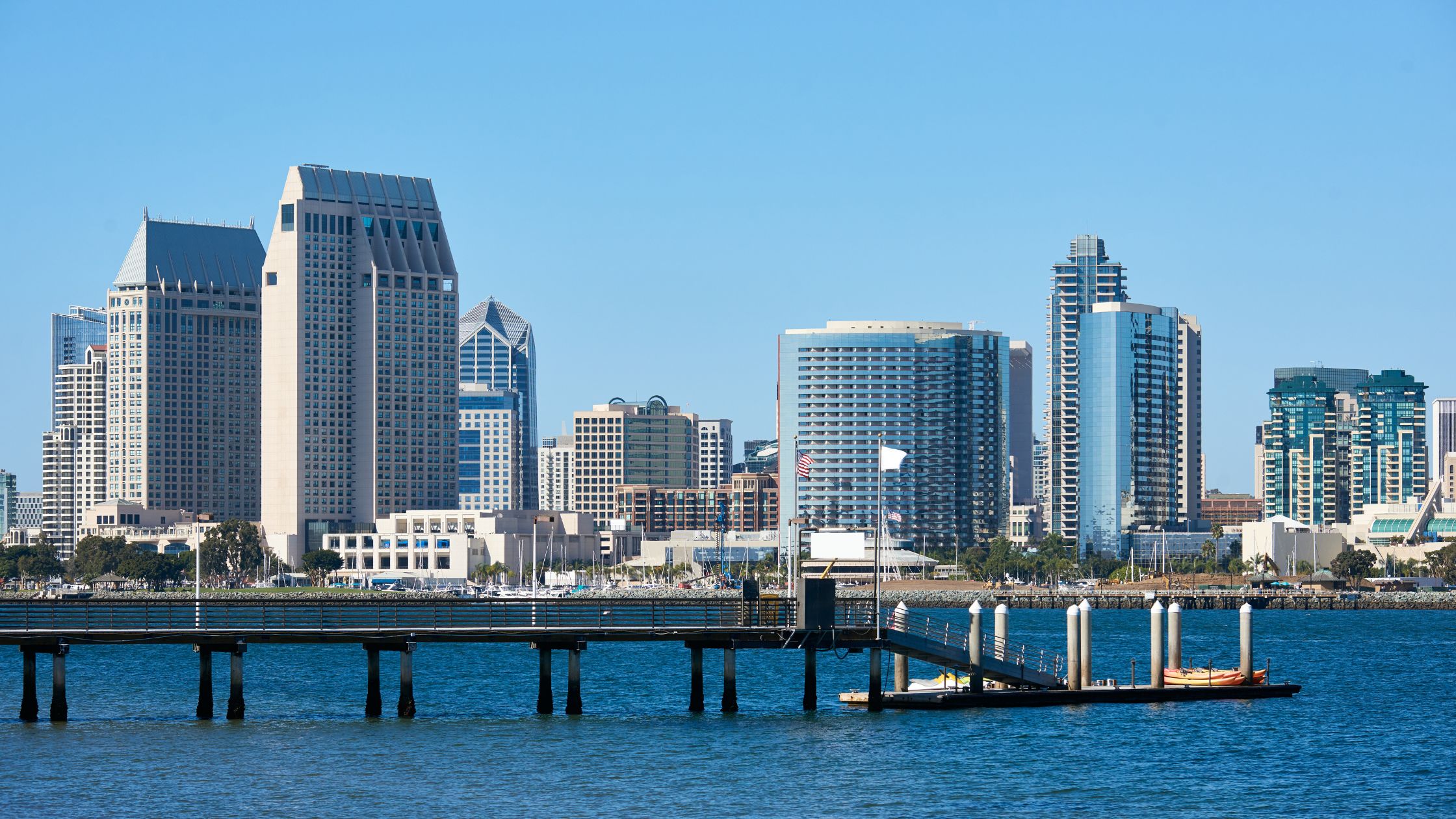California’s overall real estate market has entered a new phase. Regulatory changes, inflation, and the fallout from recent wildfires have disrupted development timelines and increased costs. But it’s not all hopeless.
There are bright spots in California real estate forecasts for 2025: industrial demand remains high and housing supply is finally beginning to loosen in some regions.
In this post, we’ll break down the current California commercial property investment outlook for 2025, covering residential, commercial, and industrial activity.
We’ll also highlight regional real estate trends in California for 2025 and pinpoint potential investment openings that could define the year.
California real estate snapshot: Where we stand today
Median property values
The average home in California is now valued at about $796,255, reflecting a modest 1.3% year-over-year increase. But statewide figures don’t tell the full story.
In San Jose, for example, the median sale price hit $2.02 million — a 9.8% jump that made it the first U.S. city to cross the $2 million threshold.
On the commercial side, Los Angeles County saw a steep drop-in activity. Sales volume fell by 18.4% year-to-date in Q3 2024 and cap rates have continued to climb as investors reassess pricing and risk.
Vacancy rates, rental yield trends
Orange County’s apartment market tightened in early 2025 with vacancy falling to 3.6% (down from a peak of 5.4% in mid-2023).
Other metros show similar resilience. In Q2 2024, rental vacancy rates dropped below 5% in Sacramento, San Jose, Los Angeles, and Riverside-San Bernardino.
State-wide migration trends
Migration data is mixed. Some reports show California continued to see net domestic outmigration in 2023 with a population loss of over 75,000 residents — many heading to states like Texas.
However, Governor Gavin Newsom announced in 2025 that prior population estimates missed a large wave of international arrivals.
Between 2021 and 2024, California welcomed 277,468 more immigrants than originally reported — this pushed the state back into net population growth territory in 2023 and 2024.
Demand vs. supply dynamics
Low inventory has long defined California’s residential property market, where homes often attract multiple offers within days of being listed.
But supply trends started to shift in early 2025.
In February, the number of homes for sale jumped 44% compared to the previous year — this influx of listings hints at a potential rebalancing between buyers and sellers, even though demand remains high in many areas.
Key Economic & Policy Drivers to Watch in 2025
Federal interest rate policies and inflation outlook
As of May 2025, the Federal Reserve has kept the benchmark interest rate steady between 4.25% and 4.50%. Ongoing supply chain challenges and the possibility of new tariffs continue to loom over the market even though inflation has eased to around 2.3%.
California tax policies and housing legislation
The latest update to Senate Bill 9 seeks to remove local barriers to building accessory dwelling units (ADUs).
The 2025 revision allows the state’s Department of Housing and Community Development to override local ordinances that conflict with state law.
This change is intended to boost housing density in single-family neighborhoods by ensuring that local governments support new ADU development.
Rent control updates
Assembly Bill 1157 — which was introduced to tighten rent caps and limit exemptions —failed to pass due to strong resistance from the California Apartment Association.
Existing rent control measures will remain unchanged throughout 2025 as a result, preserving the current framework for landlords and tenants.
Remote work and its ongoing impact on office and residential demand
Some tech firms — notably Coinbase — have reopened their physical offices, but this hasn’t reversed the broader trend.
Office space demand remains muted across many urban centers while residential demand has shifted toward suburban areas.
Tech sector performance
California tech companies cut 17,874 jobs in Q1 2025, with Meta, Google, Autodesk, and Workday among those reducing staff.
Environmental regulations impacting construction and development
California’s environmental laws, especially CEQA, have long slowed new housing projects.
In 2025, lawmakers are pushing reforms to speed up approvals and address the housing shortage. If passed, these changes could accelerate residential and mixed-use development.
Sector-wise breakdown of the 2025 outlook
Residential real estate
Prices have largely leveled out since rebounding from a dip in early 2024. Throughout the rest of the year, average home prices stayed in the $800,000 to $850,000 range — and that stability is expected to carry into 2025. There are obvious regional variations.
San Jose’s home prices jumped 11.2% year-over-year in January 2025 — up from 6.6% the month before. Tustin saw a similar rebound after a temporary dip.
On the flip side, markets like San Francisco and Oakland continue to fall.
San Francisco’s median list price has dropped $400,000 since its 2022 peak and now sits at $1.2 million, and Oakland’s median price fell from $1 million in 2022 to $705,000 in early 2025.
Price growth has slowed the most in Southern California counties like Humboldt, Trinity, and Mendocino, while areas seeing an influx of buyers due to wildfire migration are feeling some upward pressure. Even so, prices seem to be flattening across much of the state.
Office and retail
Remote work is still putting a lot of pressure on office leasing — in fact, analysts expect vacancy rates to hit 14.2% in 2025.
Many startups and smaller firms are sticking with co-working setups that let them expand or shrink without committing to long-term leases.
Even larger companies are rethinking their office investment — many are looking at flexible formats that suit the rotating schedules and space-sharing needs of hybrid work arrangements.
Lease rates are ticking up slowly: They have climbed from $3.75 per square foot in 2022 to a projected $3.95 in 2025.
That 1.8% annual growth points to a slow rebound, driven mainly by sectors that need in-person space, such as local government agencies and education.
Long-term, the future of office space really depends on whether or not businesses formalize hybrid work and reinvest in physical space.
Demand remains soft in some sectors, but landlords who offer flexible lease terms will be better positioned to fill vacancies and appeal to a wider range of tenants.
California Commercial Real Estate outlook shows changes in the retail market as well. Retail lease rates have grown from $2.90 in 2022 to a projected $3.10 in 2025 (or by about 2.2% every year). Vacancy should level off at 10.3% as the sector stabilizes.
Grocery-anchored neighborhood centers remain strong, especially in densely populated areas. Luxury retail is also holding steady as high-end shoppers continue to value in-person experiences.
Industrial and logistics
Industrial real estate should be one of California’s most active sectors going into 2025. Demand remains strong thanks to the rise of e-commerce and California’s central role in global shipping. Lease rates have increased from $1.25 per square foot in 2022 to a projected $1.40 by 2025 — a 3.8% annual growth.
The Inland Empire, Central Valley, and Bay Area are seeing the most growth. These regions have become critical for logistics and distribution because of their access to major ports (like Los Angeles and Long Beach) and their strong transportation networks.
Regional investment opportunities in 2025
Commercial real estate demand in smaller metros
Investors and developers are turning their attention inland as affordability declines in California’s coastal cities.
Cities like Sacramento, Fresno, and Bakersfield have become particularly attractive due to lower costs and growing populations — not to mention available land.
These smaller metros can be solid alternatives for CRE investors looking to step away from the high competition and limited inventory along the coast.
Strategic trade hubs
California’s industrial real estate remains one of its most active segments thanks to the state’s position as a global logistics center.
Ports in Los Angeles, Long Beach, and Oakland keep warehouse demand high, while retail is shifting toward grocery-anchored centers, luxury districts, and experience-focused spaces to meet changing consumer habits.
Growth of areas around LA County
The LA wildfires have taken a toll on the local housing market, but other regions are seeing renewed momentum.
Sacramento and Fresno, for instance, are reporting a rise in construction permits, even as building activity declines in places like San Jose and San Francisco.
San Diego County is also picking up pace. San Diego City remains one of the most appealing housing markets in the country.
Surrounding metros could see even stronger demand and development in the months ahead as people displaced from LA look for new housing.
Challenges and risks to monitor
Legislative uncertainty
The Tenant Protection Act caps rent increases at 5% plus the local inflation rate (or 10%, whichever is lower). But local ordinances may impose stricter limits and create a patchwork of rent rules that complicate pricing and investment decisions.
Labor shortages in construction and trades
California’s construction firms are struggling to find skilled workers, especially for roles like bricklayers, plumbers, and sheet metal workers. Many are bringing in talent from out of state, but that doesn’t solve the core problem: too few young people are entering the trades.
High pay hasn’t been enough to attract workers. California construction professionals earn some of the highest wages in the country, yet a 2017 report showed that only 3% of young adults were interested in construction careers.
This shortage is holding back both residential and commercial development. Even with some areas expanding, high housing costs make it hard for workers, especially in construction, to live near job sites, slowing down key projects and adding strain to already tight markets.
Interest rate uncertainty
The Fed started lowering rates in 2024, but it’s uncertain where things go from here. Much depends on how inflation behaves and what direction the new administration takes. If prices climb again, borrowing could stay expensive and make it harder to secure financing for California commercial property investments.
Insurance and wildfire risk
Insuring properties in high-risk areas in California is getting harder — and more expensive — as natural disasters intensify. Owners and developers need to take a long-term view.
Depending on the property type and location, it might make sense to retrofit buildings with energy-efficient systems to reduce premiums. CRE investors also need to carefully assess deals in wildfire-prone areas where commercial property insurance may be limited or prohibitively costly.
Conclusion
California real estate forecasts for 2025 point to uneven growth across sectors.
Industrial demand should remain strong because of e-commerce and trade logistics. In retail, grocery-anchored and luxury spaces are expected to outperform traditional formats.
Smaller metro areas are drawing more investment as high costs and wildfire disruptions push activity beyond coastal hubs.
Meanwhile, climbing vacancy rates due to the persistence of hybrid work will likely keep office leasing soft.
Investors need to be prepared to deal with overlapping challenges and constraints: labor shortages slowing construction, inconsistent policy signals, and growing climate-related insurance risks.
To move projects forward, investors need clear California commercial property investment data and reliable financing for fast-moving conditions.
Private Capital Investors and their expert team of private commercial real estate lenders can help you secure the right capital structure with creative funding solutions.





